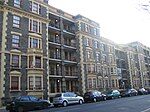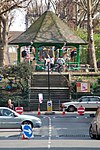Sivill House
Berthold Lubetkin buildingsResidential skyscrapers in LondonShoreditchSkyscrapers in the London Borough of Tower Hamlets

Sivill House is a Grade II listed 76-flat council housing block on Columbia Road in Shoreditch, in the London Borough of Tower Hamlets. The building has 19-storeys, at a total height of 59 m (194 ft).Sivill House was designed in the Constructivist style by Douglas Bailey, Francis Skinner and Berthold Lubetkin, the successors to the Tecton Group, and was completed in 1962. The nearby Dorset Estate was also designed by the same team.
Excerpt from the Wikipedia article Sivill House (License: CC BY-SA 3.0, Authors, Images).Sivill House
Columbia Road, London Whitechapel
Geographical coordinates (GPS) Address External links Nearby Places Show on map
Geographical coordinates (GPS)
| Latitude | Longitude |
|---|---|
| N 51.528611111111 ° | E -0.072222222222222 ° |
Address
Sivill House
Columbia Road
E2 7NN London, Whitechapel
England, United Kingdom
Open on Google Maps








